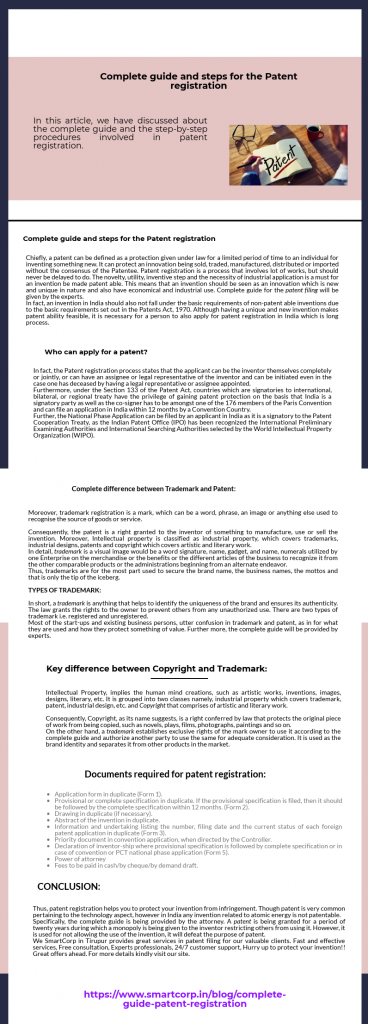
Complete guide and steps for the Patent registration
In this article, we have discussed about the complete guide and the step-by-step procedures involved in patent registration.
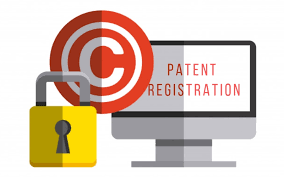
Chiefly, a patent can be defined as a protection given under law for a limited period of time to an individual for inventing something new. It can protect an innovation being sold, traded, manufactured, distributed or imported without the consensus of the Patentee. Patent registration is a process that involves lot of works, but should never be delayed to do. The novelty, utility, inventive step and the necessity of industrial application is a must for an invention be made patent able. This means that an invention should be seen as an innovation which is new and unique in nature and also have economical and industrial use. Complete guide for the patent filing will be given by the experts.
In fact, an invention in India should also not fall under the basic requirements of non-patent able inventions due to the basic requirements set out in the Patents Act, 1970. Although having a unique and new invention makes patent ability feasible, it is necessary for a person to also apply for patent registration in India which is long process.
Complete Guide for the advantages of patent registration
The advantages of patent registration:
Exclusive authority over the invention
For instance, registering a patent gives the patent holder the exclusive rights to protect from others being using the patented inventions without the permission. On the hand, the patent owner can choose on whom to give the permission to use under certain terms and conditions.
Right to sue the third party in case of infringement
Moreover, the patent registration provides the patent holder the legal right to file a case of infringement, if anyone tries to exploit the patent without the patentee’s permission. He/she can fill a case in civil suit in a court nor lower than district court according to the complete guide in case of infringement.
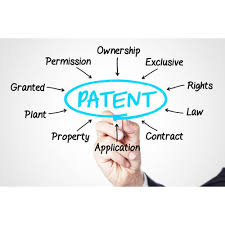
Increases your credibility in the market
As a result, If an invention is patented, indirectly rush the brand recognition and credibly empower the business to charge a premium price to the customers. Especially, if a product has great usefulness in the market then it would help to expand the valuation of the patentee’s business.
Monetary Returns
Therefore, the patent filing is a great asset and has a potential to extract way bigger monetary benefits than any other intellectual property if managed intelligently. The owner can right to sell, assign or license its patent whenever needed. Many pharmaceutical industries have great profits through their patented products by ways of licensing, assigning and selling etc.
Who can apply for a patent?
In fact, the Patent registration process states that the applicant can be the inventor themselves completely or jointly, or can have an assignee or legal representative of the inventor and can be initiated even in the case one has deceased by having a legal representative or assignee appointed.
Furthermore, under the Section 133 of the Patent Act, countries which are signatories to international, bilateral, or regional treaty have the privilege of gaining patent protection on the basis that India is a signatory party as well as the co-signer has to be amongst one of the 176 members of the Paris Convention and can file an application in India within 12 months by a Convention Country.
Further, the National Phase Application can be filed by an applicant in India as it is a signatory to the Patent Cooperation Treaty, as the Indian Patent Office (IPO) has been recognized the International Preliminary Examining Authorities and International Searching Authorities selected by the World Intellectual Property Organization (WIPO).
Complete difference between Trademark and Patent:
Moreover, trademark registration is a mark, which can be a word, phrase, an image or anything else used to recognise the source of goods or service.

Consequently, the patent is a right granted to the inventor of something to manufacture, use or sell the invention. Moreover, Intellectual property is classified as industrial property, which covers trademarks, industrial designs, patents and copyright which covers artistic and literary work.
In detail, trademark is a visual image would be a word signature, name, gadget, and name, numerals utilized by one Enterprise on the merchandise or the benefits or the different articles of the business to recognize it from the other comparable products or the administrations beginning from an alternate endeavor.
Thus, trademarks are for the most part used to secure the brand name, the business names, the mottos and that is only the tip of the iceberg.
Types of Trademark:
In short, a trademark is anything that helps to identify the uniqueness of the brand and ensures its authenticity. The law grants the rights to the owner to prevent others from any unauthorized use. There are two types of trademark i.e. registered and unregistered.
Most of the start-ups and existing business persons, utter confusion in trademark and patent, as in for what they are used and how they protect something of value. Further more, the complete guide will be provided by experts.
Key difference between Copyright and Trademark:
Intellectual Property, implies the human mind creations, such as artistic works, inventions, images, designs, literary, etc. It is grouped into two classes namely, industrial property which covers trademark, patent, industrial design, etc. and Copyright that comprises of artistic and literary work.
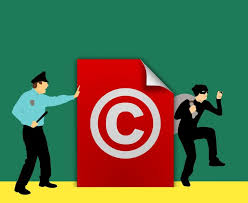
Consequently, Copyright, as its name suggests, is a right conferred by law that protects the original piece of work from being copied, such as novels, plays, films, photographs, paintings and so on.
On the other hand, a trademark establishes exclusive rights of the mark owner to use it according to the complete guide and authorize another party to use the same for adequate consideration. It is used as the brand identity and separates it from other products in the market.
Comparison between Copyrights, patents and Trademarks:
| COPYRIGHTS | PATENTS | TRADEMARKS | |
| What’s Protected? | Original works of authors, such as books, articles, songs, sound recordings, photographs, sculptures, choreography, motion pictures, and other works | Inventions, such as processes, machines, manufactures, compositions of matter as well as improvements to these | Any word, phrase, symbol, and/or design that identifies and distinguishes the source of the goods of one party from those of others |
| Requirements to be Protected | In copyright, work must be original, creative and fixed in a tangible medium | An invention must be new, useful and nonobvious | A mark must be distinctive (i.e., that is, it must be capable of identifying the source of a particular good) |
| Term of Protection | Author’s life plus 70 more years. | The patent is valid for 20 years | For as long as the mark is used in commerce |
| Rights Granted | Right to control the reproduction, making of derivative works, distribution and public performance and display of the copyrighted works | Right to prevent others from making, selling using or importing the patented invention | Right to use the trademark and to prevent others from using similar marks in a way that would cause a likelihood-of-confusion about the origin of the goods or services. |
Documents required for patent registration:
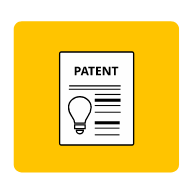
- Application form in duplicate (Form 1).
- Provisional or complete specification in duplicate. If the provisional specification is filed, then it should be followed by the complete specification within 12 months. (Form 2).
- Drawing in duplicate (if necessary).
- Abstract of the invention in duplicate.
- Information and undertaking listing the number, filing date and the current status of each foreign patent application in duplicate (Form 3).
- Priority document in convention application, when directed by the Controller.
- Declaration of inventor-ship where provisional specification is followed by complete specification or in case of convention or PCT national phase application (Form 5).
- Power of attorney
- Fees to be paid in cash/by cheque/by demand draft.
Conclusion:
Thus, patent registration helps you to protect your invention from infringement. Though patent is very common pertaining to the technology aspect, however in India any invention related to atomic energy is not patentable.
Specifically, the complete guide is being provided by the attorney. A patent is being granted for a period of twenty years during which a monopoly is being given to the inventor restricting others from using it. However, it is used for not allowing the use of the invention, it will defeat the purpose of patent.
We SmartCorp in Tirupur provides great services in patent filing for our valuable clients. Fast and effective services, Free consultation, Experts professionals, 24/7 customer support, Hurry up to protect your invention!! Great offers ahead. For more details kindly visit our site.
